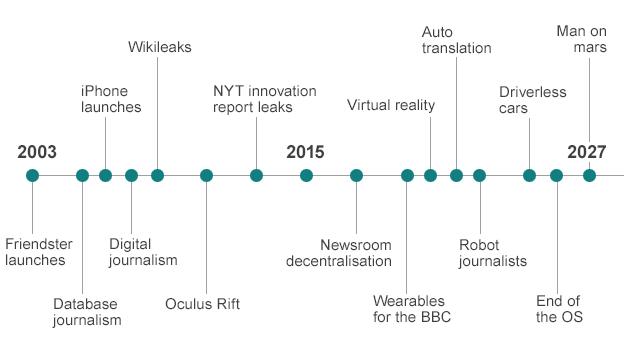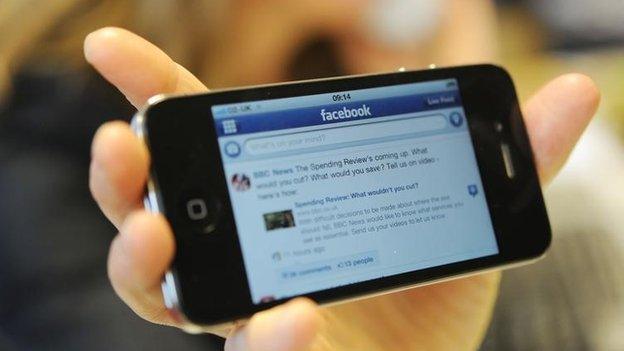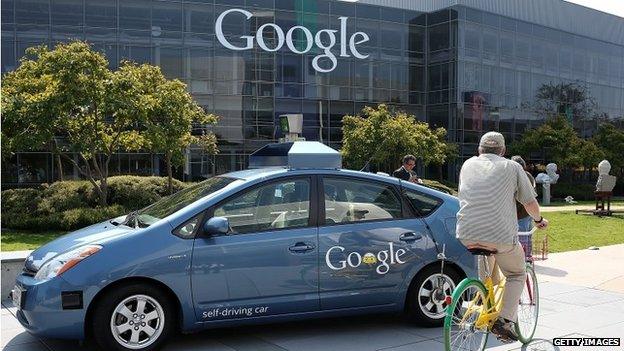Future of News: Timeline of the connected generation
- Published

Predicting the future is a challenge at the best of times. During the current period of rapid technological change, it is particularly tricky. Undaunted, the innovation team at BBC News Labs have tried their hand here at charting a timeline of key future developments for technology and news, as well as some recent milestones.
2003: Friendster, the first social network, launches
Its initial success will be followed by even more popular social networks taking over, namely Facebook in 2004, and Twitter in 2006.
2005: Database journalism
After launching an ambitious mapping of crime in Chicago, chicagocrime.org, external, in 2005, Adrian Holovaty's 2006 manifesto focuses on the shape of the information, and not only on the story. It develops a programmatic and re-usable approach to newsworthy material.
2006: Twitter
In addition to being a very successful social network, Twitter changed the way journalists and news work - in only 140 characters.
2007: Apple introduces the iPhone
Beginning of the smartphones era. These phones distinguish themselves by their ability to extend their capabilities through third-party apps.

Social media has changed the way journalists work
2008: The rise of the digital journalist
File-based audio recorder, FTP, and laptop editing take over newsrooms and lay out the basics for mobile and on-the-go from-the-field journalism. Podcasting and video-journalism are results of successful experiments from news organisations.
2010: Wikileaks changes the rules
By dumping massive leaked datasets online, Julian Assange's Wikileaks blurs the lines between journalism and the Internet. Many wonder whether Wikileaks is a journalistic organisation.
2012: Oculus Rift VR kit
Oculus releases its virtual reality head-mounted display, with a Development Kit, laying the ground for accessible and modern VR.
2014: New York Times innovation report leaks
The Nieman Lab, external wrote that this report "is one of the key documents of this media age." It highlights the conflict and frustration in one of the most digitally successful newsrooms.
2016: First news organisation with no central newsroom
Mobile journalism technologies are mature enough to be used to create a full publication directly from reporters' phones in the field, from newsgathering to publishing.
2018: Standard BBC reporter equipment includes wearables
Optical head-mounted cameras' rival broadcast cameras for quality and are used for first-person action views. Tim Pool is regarded as pioneer of the genre.
2019: Virtual reality headsets tops Christmas sales
A large selection of virtual reality ready video games, entertainment programmes and movies, combined with the falling price of a VR headset, lead to record sales and a larger adoption.
2020: First automatically translated and global BBC broadcast
Thanks to cutting-edge language technologies, a single package can be consumed in every language at the same time, without additional work from journalists or translators.

2021: First BBC News stories written by a robot
With years of machine-learning and experiments in automated-writing for repetitive articles (company financial results, for example), computers are now capable of compiling more complex stories.
2024: Autonomous driving becomes mainstream
A special test is added to the driving licence exam, and driverless cars are considered much safer for road users. Their adoption by the retired and disabled is massive.
2025: The visible Operating System disappears, becomes ubiquitous
Screen and device agnosticity is now the rule, as we now interact constantly with an invisible OS, allowing us to deploy virtual screens everywhere.
2027: Man lands on Mars
Dutch non-profit Mars One sends four astronauts to Mars to establish the first permanent human colony, beating NASA's Orion by a decade.
You can learn more about BBC News Labs on their blog, external.